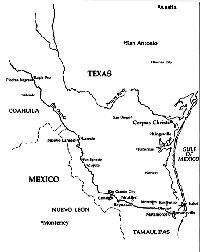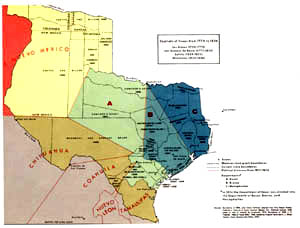HISTORY OF BORDER CONFLICT
Before it was Texas: the Lower Border region 1767-1848
Along with quite a bit of the Southern United States, Texas was once a part
of the Spanish Empire. The region of focus in this analysis is the land
that lies between the Río Grande River and the Nueces River. Under
Spanish rule, this tract of land was the called La Colonia de Nuevo Santander.
Under Méxican rule it was called Tamaulipas. Today, we call this
region the Lower Border region of Texas. The people that settled in this
region during colonial Spanish rule eventually formed communities who were
both resilient, practical and independent, who were able to encorporate
themselves into the lower valley despite the substantial Tejano-Anglo social
and economic tensions (Alonzo, 52).
|
Fig.1 Map taken from A Texas-Mexican Cancionero (Paredes, xii) |
Starting in 1767, the Spanish throne began assigning tracts of land to citizens that settled in Nuevo Santander. In order to receive a land grant, called a porción, settlers had to agree to raise livestock, including cattle, on their land. For this reason, each tract of land had access to water, which in many cases meant is was located along the Río Grande. After México won its independence from Spain in 1821, ranching was still one of the principal economic activities in the Río Grande Region (Alonzo, 67). [See Fig. 2]
|
Fig. 2 Map taken from Cultural and Historical Maps of Texas (Ellis, Jordan, and Buchanan, 20) |
As early as the 1820's, hundreds of Anglo settlers began to trickle in from the United States into the Coastal Plains of Texas, which was currently Mexico, creating a significant population increase. This settlement is described by Rudoflo Acuña in his book Occupied America,
"Large numbers of Anglo-Americans entered Texas in the 1820s as refugees from the [United States] depression of 1819. In the 1830s entrepreneurs sought to profit from the availability of cheap land. By 1830 there were about 20,000 settlers with some 2,000 slaves." (7)
Anglo-Americans settling in southern U.S. had come to depend on slave labor for their economic livelihood. Slave labor gave them a great economic advantage over the established Mexican economy of ranching and farming in the disputed border region (Acuña, 7). When Mexico outlawed slavery in 1829, Anglos settlers in Mexico saw it as an infringement of their liberties and became resentful of Mexican authority. Then in 1830, Mexico outlawed any further immigration from the United States, which caused further conflict. In 1832, a convention of Anglo settlers was held, and a resolution was drafted that called for an autonomous Texas as its own Mexican state and for the repeal of the restriction on U.S. immigration (Acuña, 8). Upon failure to persuade the Mexican government to concede to their demands, some Anglo-Americans began to support the idea of taking Texas by force. Fighting broke out in September of 1835 and ended in April of 1836 with Texas an independent nation. This marked one of the first large-scale confrontations along the Texas-Mexico border. The territory claimed by Texas included the land between the Nueces River and the Red River, extending into some parts of present-day New Mexico. This victory paved the way for the Mexican-American War of 1848 when Texas would join the United States as an independent state(Acuña, 9).
Conflict continued in the border area. Even after the Texas-Mexican War,
Mexico had not ceded the land below the Nueces River claiming it as part
of Mexico. In the spirit of U.S. expansionism the United States made a bold
move and annexed Texas in 1845, claiming that the Rio Grande marked the
lower border of Texas, whereas Mexico still viewed the border at the Nueces
River. Mexico halted diplomatic relations with the United States, and President
Polk sent the U.S. Army into Texas to “protect” the border (Acuña
12). Fighting broke out among the US troops led by General Zachary Taylor
and the Mexican troops that had been stationed along the border in preparation
for the arrival of conflict. Thus started the Mexican-American war. The
United States would not officially have control over the border area until
the end of the war in 1848 with the Treaty of Guadalupe Hidalgo (Alonzo,
10). With a tentative alliance, Tejano and Anglo ranchers which had been
developing as an important part of economic life along the border, would
be a part of the developing cattle industry (Alonzo, 73).

